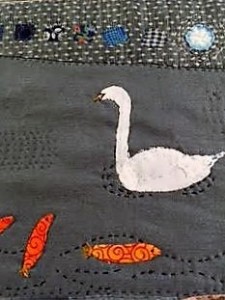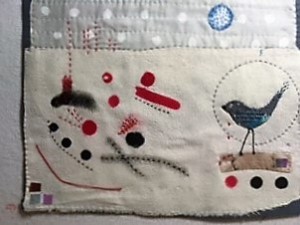March is National Quilting Month. Poor Yorick celebrates with a series of essays reflecting upon this time-honored craft.

Anyone can make a quilt. Seriously, anyone can do it. It’s like making a peanut butter sandwich, only with cloth, using the simplest tools imaginable: a sewing machine, or a sewing needle, and some thread. The truth is, it’s not hard, it’s immensely satisfying, and you can sleep under the finished product. Once you are lying under a cloth sandwich that was handmade, it’s hard not to love this very old tradition.
I started my love affair with cloth as a child, when my mother made me learn to sew. Talk with quilters and many of them have the same story: a female relative taught them the basics. In my adult years, I began making quilts in earnest when my hyperactive little boys finally went to bed and there was some peace and quiet at night. The feel of the fabrics in my hands just made me happy. Other people who make quilts will tell you this also. When I am shopping for clothes, I have to love the way the fabric of the garment feels in my fingers or I will not buy it.

A quilt sandwich is two layers of fabric, one cut and pieced together and another whole cloth or pieced layer on the back, along with an insulating layer inside called batting. Once the batting is in the middle of the sandwich, the three layers are temporarily sewn or pinned together. Then they are hand sewn together in the design chosen, or they can be tied together, with knots through the layers at intervals small enough so the layers do not move when washed. This is my preferred method of finishing a quilt. It takes less time, and the quilt body remains softer than when it has thousands of tiny stitches through it. Knotting is also the way the most utilitarian quilts of earlier times were finished.
Back in the beginning of my quilting years, I asked my husband to shoot me if I ever made anything purely decorative. The fact that I was making a textile that we could and did use was so satisfying that I refused to see the art in the craft I was doing. The utilitarian and emotional nature of quilts was the reason I made them; like a home cooked meal, my homemade quilts gave me an almost holy warmth, a physical comfort, and helped me feel at home in my house. A quilt was touchable. The forms I sewed together were simple but strong. The geometry of the quilts’ designs was powerful and satisfying, and the quilts looked homey on our beds. After a while, I realized I could cut and sew any shape at all, that I could make the rules; after ten years of following patterns in quilting books, I decided to make up my own designs.

Then I discovered art quilts, which are mostly NOT for beds, but for display and can be made with a wide variety of materials, including metal, synthetics, and organic things like stones and shells; as long as there is an object somehow sewn to something else, the term “quilt” can hold. Although I think they are beautiful, I need to make something that can be touched and is not precious. So while I love seeing them, and am in awe of their makers, I don’t make them.
I did, however, decide to make fabric pictures, much smaller than a quilt but with fabrics sewed together by hand. Now I’m making tiny picture quilts, still using small pieces of fabric, still stitching by hand, and still enjoying the feel of the fabrics. The quilts are too small to even cover a tummy, but they are about spirit, home, women, and birds, and like the bigger quilts, they make me deeply happy. I’m taking bits of things and making them into something bigger.
There exists debate about art versus craft, about work that is meant to be contemplated versus work meant to be used. We now know that quilts fall into both camps at the same time. The Gees Bend quilts come to mind. They provide powerful visual experiences, both in person and in books, and were made to be used.
I’ve realized that whether I make a bed quilt or a tiny picture quilt, I get exactly the same feeling. Whatever someone else may call my work, to me, the maker, there is a feeling of deep joy that accompanies simply looking at something I’ve made out of cloth. No one else has to love it, although it’s fun when someone else does. My love is enough.
Annelieke Schauer
Contributor
About the Author
Annelieke Schauer is a textile artist based in Hartford, Connecticut.
